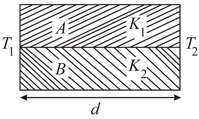Embibe Experts Solutions for Chapter: Heat Transfer, Exercise 4: Exercise (Previous Year Questions)
Embibe Experts Physics Solutions for Exercise - Embibe Experts Solutions for Chapter: Heat Transfer, Exercise 4: Exercise (Previous Year Questions)
Attempt the practice questions on Chapter 16: Heat Transfer, Exercise 4: Exercise (Previous Year Questions) with hints and solutions to strengthen your understanding. Beta Question Bank for Medical: Physics solutions are prepared by Experienced Embibe Experts.
Questions from Embibe Experts Solutions for Chapter: Heat Transfer, Exercise 4: Exercise (Previous Year Questions) with Hints & Solutions
Three objects coloured black, grey and white can withstand hostile conditions up to . These objects are thrown into a furnace where each of them attains a temperature of . Which object will glow brightest?
The total radiant energy per unit area, normal to the direction of incidence, received at a distance from the centre of a star of radius , whose outer surface radiates as a black body at a temperature is given by
(where is Stefan's constant)
A piece of iron is heated in a flame. It first becomes dull red, then becomes reddish yellow, and finally turns to white-hot. The correct explanation for the above observation is possible by using
A black body is at a temperature of . The energy of radiation emitted by the body at wavelength is at wavelength is and that at is . Wien’s constant, . Which of the following is correct?
A body cools from a temperature 3T to 2T in 10 minutes. The room temperature is T. Assume that Newton’s law of cooling is applicable. The temperature of the body at the end of next 10 minutes will be :-
The temperature inside a refrigerator is and the room temperature is . The amount of heat delivered to the room for each joule of electrical energy consumed ideally will be:-
A tungsten body of diameter is at . lt radiates of the energy radiated by a black body of the same radius and temperature. Find the radius of the black body which will radiate energy at the same rate at the same temperature?
Two rods A and B of different materials are welded together as shown in figure. Their thermal conductivities are K1 and K2. The thermal conductivity of the composite rod will be :-

